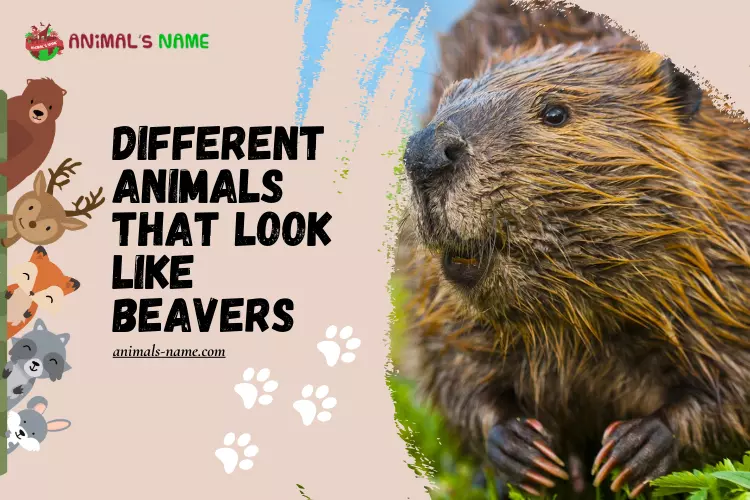Hey there, curious minds! Get ready to dive into the fascinating world of animals that look like beavers. While beavers are known for their unique appearance and excellent dam-building skills, other critters might make you double-take.
In the United States, where nature is as diverse as the people, you’ll find these remarkable creatures that resemble our friendly neighbourhood beavers. From their furry coats to busy lifestyles, these animals share some intriguing similarities with the iconic beaver.
We’ll take you on a journey through rivers, wetlands, and forests to meet these doppelgangers. You’ll discover why nature has designed them to look the way they do and how they play essential roles in their ecosystems, just like our beloved beavers.
So, get ready to meet some surprising animal look-alikes and learn about the beautiful world of wildlife right in your backyard. Whether you’re a nature enthusiast or just curious about the creatures that share our planet, this adventure is for you. Let’s explore the animals that could easily be mistaken for beavers and uncover the secrets of their remarkable lives! Animals Name
1. Muskrat
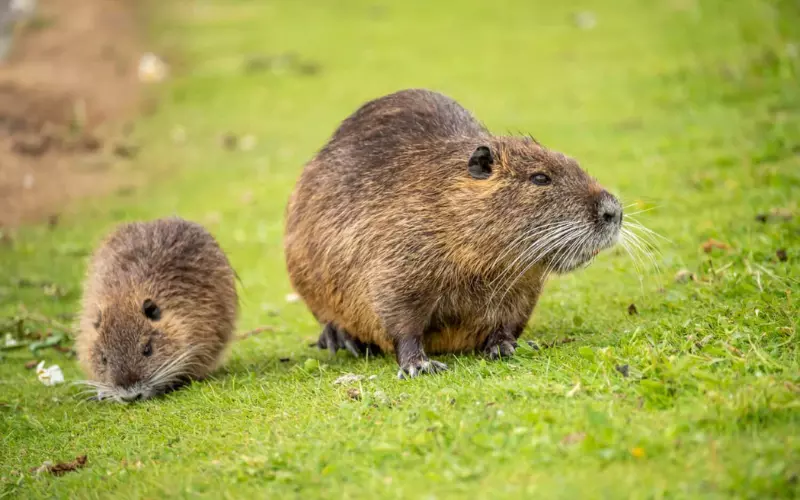
The muskrat, scientifically known as Ondatra zibethicus, is a fascinating little creature found in North America. These small mammals make their homes near water, often in wetlands, ponds, and streams. Muskrats strongly prefer watery habitats, and you can spot them building dome-shaped houses, called lodges, using plants, mud, and sticks.
Muskrats are small, usually measuring around 10 to 14 inches (25 to 35 centimetres), with a tail of about 7 to 11 inches (18 to 28 centimetres). They have brown fur that helps them blend into their surroundings, which is essential for staying safe from predators.
Muskrats are excellent swimmers who can hold their breath while diving underwater. They use their webbed hind feet like paddles, and their tails act as a rudder. These little engineers play an important role in their ecosystem by helping to control wetland vegetation and creating habitats for other wildlife.
So, when you see a small, brown, and furry creature near the water, it might just be a muskrat working hard to make its home in the wetlands of North America.
2. Nutria
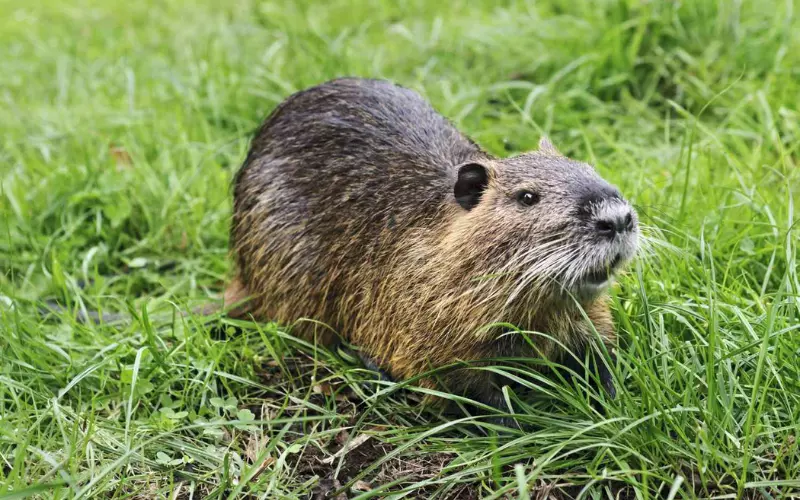
The nutria, known scientifically as Myocastor coypus, is another interesting animal in various parts of the world, including North America. These creatures love to live near water, such as rivers, lakes, and marshes. You can often spot them in wetlands, where they feel at home.
In terms of size, nutrias are about the size of a medium-sized dog. They usually measure around 16 to 24 inches (40 to 60 centimetres) and have a long, rat-like tail that can be nearly as long as their body. Their fur can range from dark brown to reddish-brown, and they have webbed feet, which makes them excellent swimmers.
Nutrias are herbivores, which means they eat plants like aquatic vegetation and roots. They’re also known for their sharp, orange teeth that grow throughout their lives.
These furry friends might resemble beavers or muskrats at first glance, but they’re unique in their own way. Nutrias are expert swimmers and play a crucial role in shaping wetland ecosystems.
3. Capybara
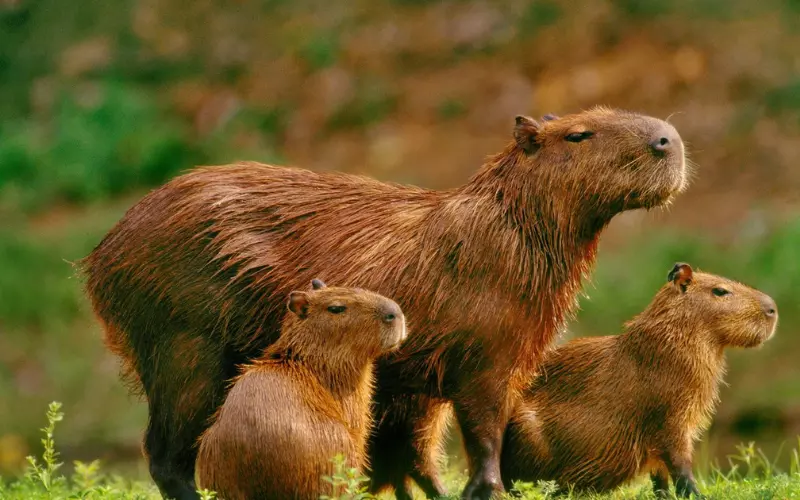
The capybara, scientifically known as Hydrochoerus hydrochaeris, is a remarkable animal in South America. These friendly creatures are known for their love of water and can often be spotted near rivers, swamps, and lakes. They prefer a habitat that combines land and water, allowing them to swim and graze on lush vegetation.
In terms of size, capybaras are the largest rodents in the world, resembling oversized guinea pigs. They can grow to be about 2 feet (60 centimetres) tall and up to 4.4 feet (135 centimetres) long. Imagine a big dog-sized rodent!
Capybaras are social animals and enjoy living in groups, sometimes called herds or gangs. Their friendly and gentle nature makes them popular with other animals, and they often share their habitat with birds and even crocodiles!
If you ever visit South America and spot a group of large, water-loving rodents, you’ve come across these fantastic capybaras enjoying their unique habitat.
4. Beaver Rat
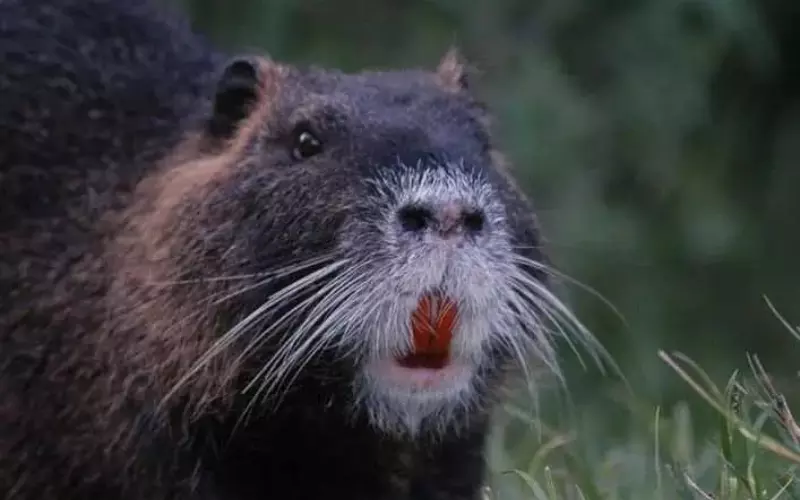
The beaver rat, scientifically known as Myocastor coypus, is an exciting animal living near North America’s water. Unlike beavers different animals, beaver rats prefer wetlands, rivers, and lakes.
In terms of size, beaver rats are medium-sized mammals. They typically grow to be about 17 to 25 inches (43 to 63 centimetres) long, not including their tails, which can add another 12 to 17 inches (30 to 43 centimetres). Their fur is usually reddish-brown, helping them blend in with their watery homes.
Beaver rats are excellent swimmers and spend much of their time in the water. They use their webbed feet to paddle and their muscular tails to steer. Just like beavers, they are known for their impressive burrows, which they dig into the banks of rivers and lakes.
So, when you see a furry creature near the water, it might be a beaver rat, making its home in the wetlands and waterways of North America.
5. Pyrenean Desman
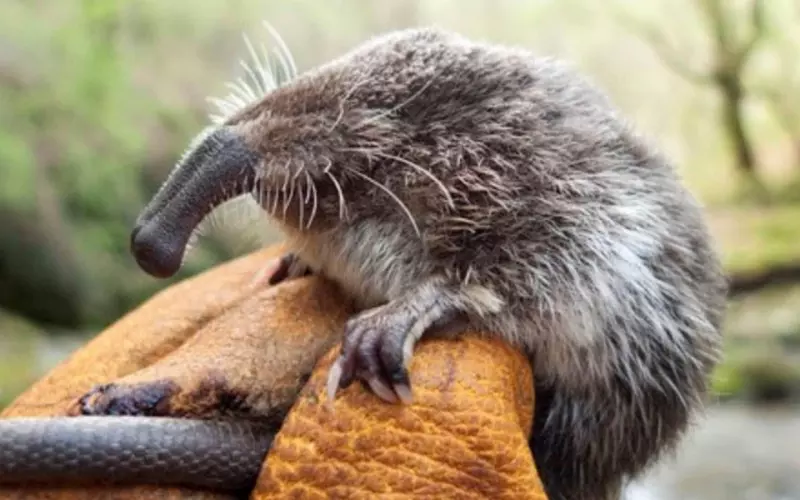
The Pyrenean desman, scientifically known as Galemys pyrenaicus, is a unique and rare creature found in the Pyrenees Mountains of Europe. These little mammals have a fascinating lifestyle, and their preferred habitat is near freshwater streams and rivers in cool, forested areas.
In terms of size, Pyrenean desmans are quite small, measuring around 4.3 to 5.5 inches (11 to 14 centimetres), with a tail nearly as long as their body. They have sleek, dark brown fur, a long snout, and webbed feet. These features make them excellent swimmers and help them catch aquatic insects and small fish for food.
Pyrenean desmans are known for their unique appearance and behaviours. They are like underwater detectives, using their sensitive snouts to search for prey in their habitats’ dark, flowing waters. Sadly, these fascinating creatures are considered endangered due to habitat loss and pollution, making them a unique and essential part of their ecosystem.
6. Platypus

The platypus, known scientifically as Ornithorhynchus anatinus, is one of the planet’s most unique and fascinating creatures. These peculiar animals are found in Australia and have a rather particular habitat preference – they love to live near freshwater streams, rivers, and lakes.
In terms of size, platypuses are relatively small, measuring about 15 to 20 inches (38 to 51 centimetres) from the tip of their snout to the end of their tail. They have a furry body covered in waterproof fur to keep them warm when swimming. But their unusual features, like their duck-like bills and webbed feet, truly set platypuses apart.
These semi-aquatic mammals are exceptional swimmers and spend much of their time underwater. They’re known for their ability to hunt underwater, using their sensitive bills to locate prey like insects and small crustaceans. Platypuses are a true wonder of nature, showcasing the incredible diversity of life on Earth.
7. Quokkas
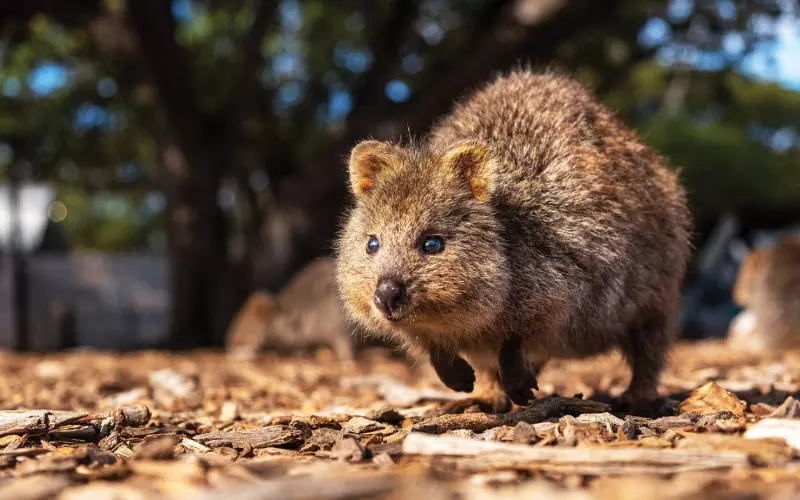
The quokka, known scientifically as Setonix brachyurus, is a charming and tiny marsupial native to Australia. These adorable creatures prefer to call islands and coastal areas home. They live in habitats like forests and shrublands, and you can often find them on Rottnest Island and some parts of Western Australia.
Quokkas are pretty small, measuring about 16 to 21 inches (40 to 54 centimetres), including their tails, which are around 9 to 11 inches (23 to 28 centimetres) long. They have round faces with friendly smiles, making them known as the “world’s happiest animal.”
These little marsupials are herbivores, meaning they eat plants and leaves and are primarily active at night. Quokkas are known for their friendly and curious nature, and they often approach humans, making them a popular subject for photos on social media.
So, when you visit certain parts of Australia and spot a small, smiling marsupial, you’ve likely encountered the delightful quokka, the “happiest” creature Down Under.
8. Marmots
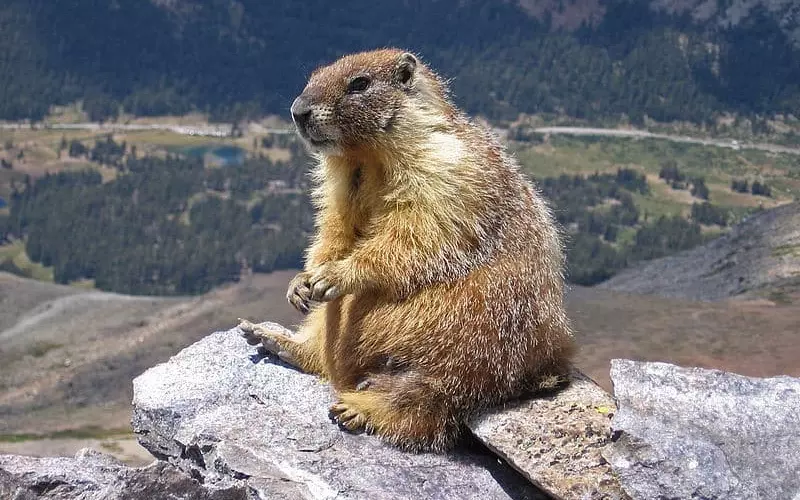
Marmots, scientifically known as Marmota, are furry creatures in various habitats worldwide, including North America and Europe. These chubby rodents prefer living in high-altitude areas, often on mountainsides, where they dig burrows in the soil. They are great at climbing and can often be seen perched on rocks or logs.
In terms of size, marmots are like the bulky cousins of squirrels. They can range from about 16 to 28 inches (40 to 70 centimetres) in length, with their bushy tails adding another 6 to 9 inches (15 to 23 centimetres). They have brown fur and are known for their round bodies, making them easy to spot.
Marmots are skilled diggers, creating intricate tunnel systems in their burrows to provide shelter and hibernation spots. They’re herbivores, munching on plants and grasses. These cute, chubby creatures are an essential part of their mountainous habitats, and you might spot them sunbathing or whistling to communicate with other marmots in their colony.
9. Woodchucks
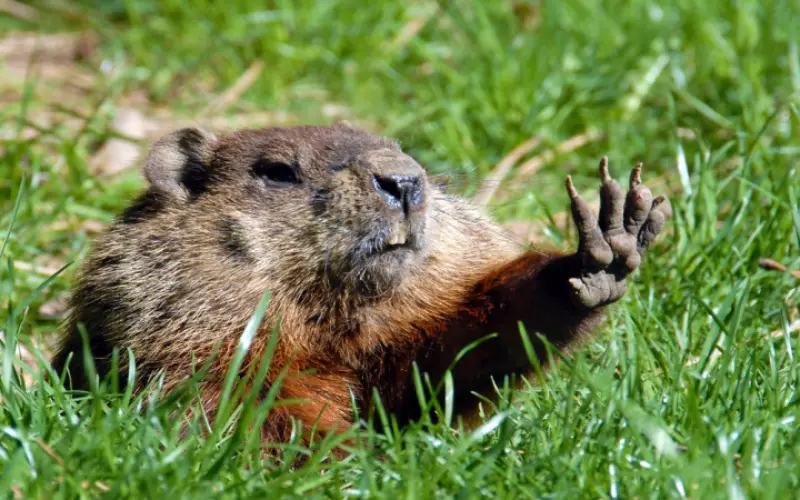
Woodchucks, scientifically known as Marmota monax, are chubby and furry ground-dwelling creatures found in North America. They are skilled diggers and prefer to make their homes in caves, often near fields, meadows, or forests. Woodchucks are excellent climbers and swimmers but mainly stick to the ground.
Woodchucks are about the size of a big squirrel, measuring around 16 to 26 inches (41 to 66 centimeters), with a short, bushy tail. They are covered in brown fur, which helps them stay warm during the colder months.
Woodchucks are known for their burrowing skills, digging tunnels, and underground chambers where they hibernate during the winter. They are herbivores, munching on plants like grasses, clover, and vegetables.
These chunky critters are famous for their ability to predict the weather, at least according to folklore. So, when you see a woodchuck in the wild, you’re looking at a skilled digger and a charming part of North America’s wildlife.
10. Water Vole

The water vole, scientifically known as Arvicola amphibius, is a charming little rodent that loves the water. These furry critters prefer to make their homes near rivers, streams, and ponds, where they can find plenty of aquatic plants to munch on. Water voles are skilled swimmers and divers, making these watery habitats perfect.
They’re not too big, measuring around 4 to 6 inches (10 to 15 centimeters), with a tail about half the length of their body. Their fur is typically brown and helps them blend in with their surroundings, providing camouflage from predators.
Water voles play an essential role in their ecosystem by helping to control the growth of aquatic plants and providing food for other animals, like owls and foxes. So, the next time you’re by a riverbank, watch for these tiny, furry swimmers—they’re nature’s little water-loving engineers!
11. American Mink
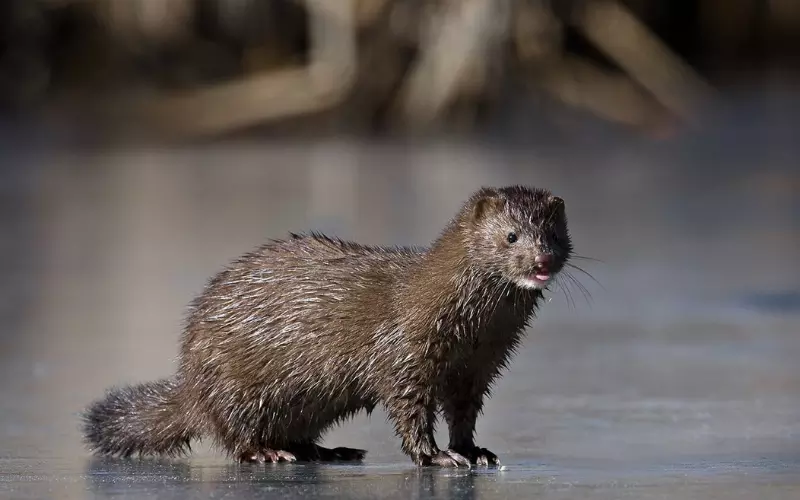
The American mink, scientifically known as Neovison vison, is a clever and agile creature. These small mammals thrive near water, favouring habitats like rivers, lakes, and marshes. With a sleek and slender body, they’re about the size of a housecat.
American minks are skilled swimmers often seen darting in and out of the water, searching for food like fish, frogs, and even small mammals. Their luxurious fur ranges from dark brown to nearly black and is highly prized by humans for making coats and hats.
These crafty critters are known for their adaptability and can be found across North America. So, next time you’re near a waterway, watch for the American mink, a small but resourceful member of the animal kingdom.
12. Southern River Otter
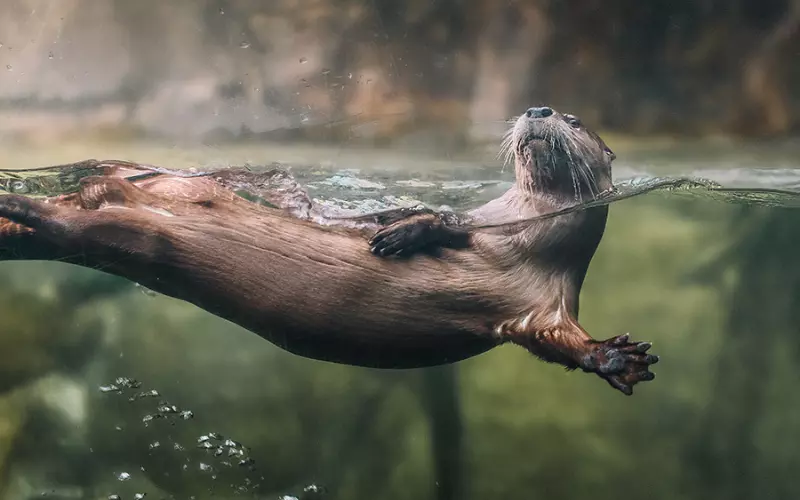
The Southern river otter, known scientifically as Lontra provocax, is a water-loving creature in South America. These otters thrive in various watery habitats, including rivers, lakes, and coastal areas. They prefer regions with plenty of fish to munch on and dense vegetation along the banks to provide shelter.
Southern river otters are about the size of a medium-sized dog, typically measuring around 2 to 3 feet (60 to 90 centimeters) in length, including their tail. They have sleek, brown fur and webbed feet, which make them excellent swimmers.
These otters are skilled hunters and use their sharp teeth to catch fish, crabs, and other aquatic prey. They are playful and social animals, often seen frolicking in the water and sliding down muddy riverbanks.
So, when you come across a playful, brown otter in South American waters, you’ve likely met the Southern river otter, a skilled swimmer and a charming member of its ecosystem.
13. Water shrew
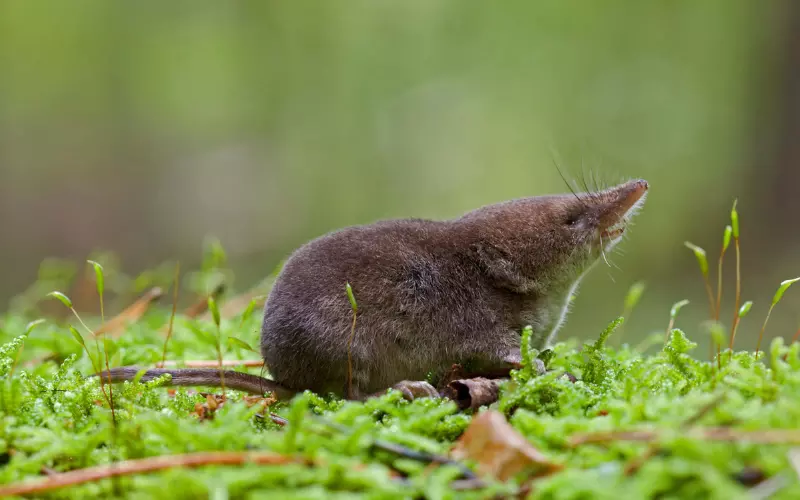
The water shrew, known scientifically as Neomys fodiens, is a tiny yet remarkable creature in Europe and parts of Asia. These shrews are like little water acrobats, as they prefer habitats near streams, rivers, and wetlands. They are skilled swimmers and divers, often seen darting through the water for food.
In terms of size, water shrews are pretty small, measuring around 3.5 to 4.7 inches (9 to 12 centimeters), with a tail that adds another 2.4 to 3.1 inches (6 to 8 centimeters). They have velvety dark brown fur on top and lighter underneath, helping them stay warm and dry while hunting for aquatic insects and small prey underwater.
These shrews are like the underwater detectives of their habitats, with their keen senses and agile movements. They play an essential role in keeping aquatic insect populations in check and maintaining the health of their watery homes. So, if you ever spot a tiny, quick-moving creature near the water in Europe or Asia, it might just be a water shrew on a mission!
14. Helan Shan Pika
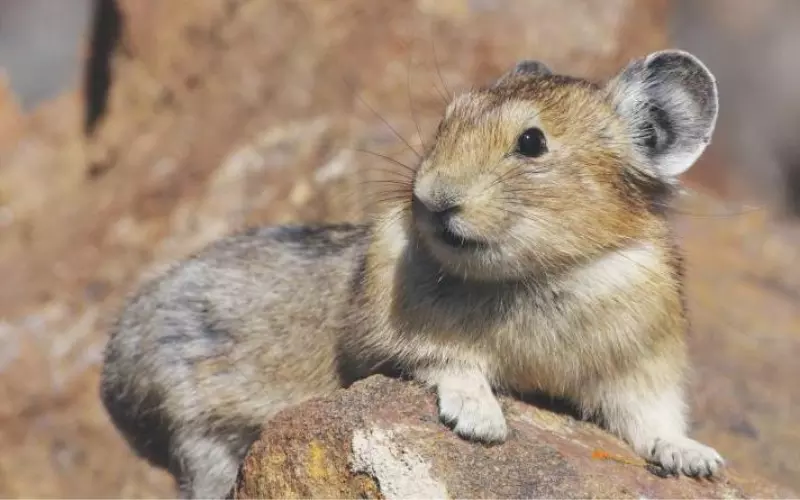
The Helan Shan pika, scientifically known as Ochotona helanshanensis, is a tiny mammal in China. These small pikas prefer high-altitude habitats, making their homes on the rocky slopes of the Helan Mountains.
They are pretty petite, measuring only about 7 to 8 inches (18 to 20 centimeters) in size, with soft, brown fur that helps them blend into their rocky surroundings.
These little creatures are herbivores, mainly eating plants like grasses and shrubs. They are essential to their ecosystem as they help control plant growth by munching on vegetation.
So, suppose you find yourself exploring the Helan Mountains in China and come across a small, furry pika. In that case, you’ve encountered the Helan Shan pika, a vital part of their mountainous habitat.
15. Russian Desman

The Russian desman, known scientifically as Desmana moschata, is a unique animal native to Russia and Ukraine. It thrives in watery habitats like rivers and ponds, often in areas with dense reeds and vegetation.
In terms of size, the Russian desman is a small critter, measuring around 8 to 12 inches (20 to 30 centimeters) in length, with a long, skinny tail that’s almost as long as its body. Its fur is dark brown, and it has a long, flexible snout for hunting underwater.
This little creature is an excellent swimmer and spends most of its life in the water. It’s specially adapted to this aquatic lifestyle with webbed feet, making it an expert at catching insects, small fish, and other aquatic prey. The Russian desman is a secretive and fascinating animal, ideally suited to its watery world.
16. Altai Pika
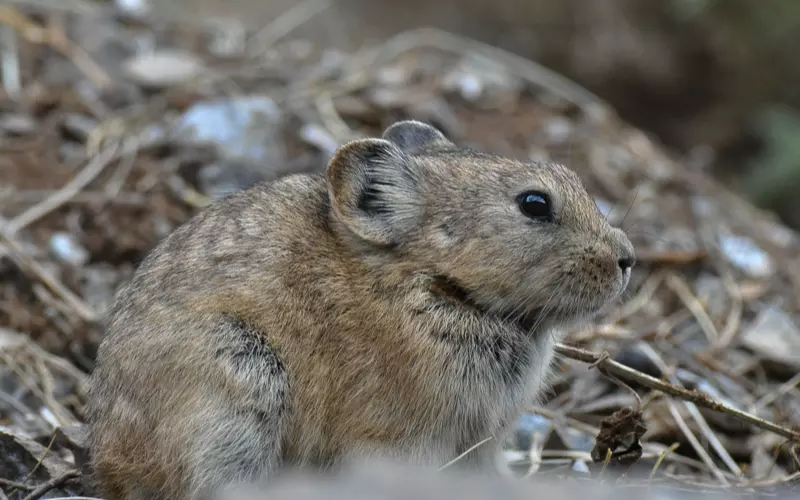
The Altai pika, scientifically known as Ochotona alpina, is a tiny mammal that calls the Central Asian mountains home. These furry critters prefer high-altitude habitats, often living in rocky areas and meadows in the Altai Mountains. They’re not very big, measuring only about 5 to 6 inches (13 to 15 centimeters), with a short, bushy tail. Imagine a cute, fluffy mouse-sized creature.
Altai pikas are well adapted to their chilly environments, with thick fur to keep them warm. They’re herbivores, munching on plants like grasses and herbs. These small herbivores play a vital role in their ecosystem by helping to control plant growth and providing food for predators like eagles and foxes.
So, picture a tiny, mountain-dwelling pika working hard to survive and thrive in the stunning landscapes of the Altai Mountains in Central Asia.
17. North American River Otter

The North American River Otter, scientifically known as Lontra canadensis, is a playful and sleek mammal commonly found in North American waterways. These otters prefer habitats like rivers, lakes, and ponds, where they can hunt for fish, frogs, and even the occasional crayfish.
In terms of size, North American River Otters are around 2.5 to 4 feet (75 to 120 centimetres) long, including their tail. They have webbed feet and a streamlined body, making them excellent swimmers. Their fur is thick and waterproof, which helps keep them warm and dry in the water.
These otters are known for their playful nature, often seen sliding down riverbanks and engaging in water games. They are skilled hunters and can hold their breath underwater for several minutes. Watch for these delightful creatures near North American water bodies; you might glimpse their aquatic antics!
Let’s Know More About Beavers
History of Beavers

The history of beavers is fascinating! These clever animals have been around for a long time, millions of years. Here’s a short story about them:
Beavers are known for their fantastic building skills. They create homes called “lodges” out of sticks and mud, which are like cosy castles in the water. But a long time ago, beavers were even more massive than today’s beavers, like as big as bears! These giant beavers roamed the Earth about 10,000 years ago during the Ice Age.
People have been fascinated by beavers for a very long time. Native American tribes like the Haudenosaunee, or Iroquois, even called themselves the “People of the Longhouse” because beaver lodges inspired their homes.
In the 1600s and 1700s, European fur trappers came to North America for beaver fur. Beaver fur was valuable for making warm hats, which were trendy back then. This led to lots of beaver trapping and, unfortunately, a decline in their numbers.
But the good news is that people realized how important beavers are for the environment. They help create wetlands and provide homes for other animals. So, today, we protect these amazing creatures and their lodges, ensuring they continue to be a part of our natural history.
Importance of Beavers in the Ecosystem
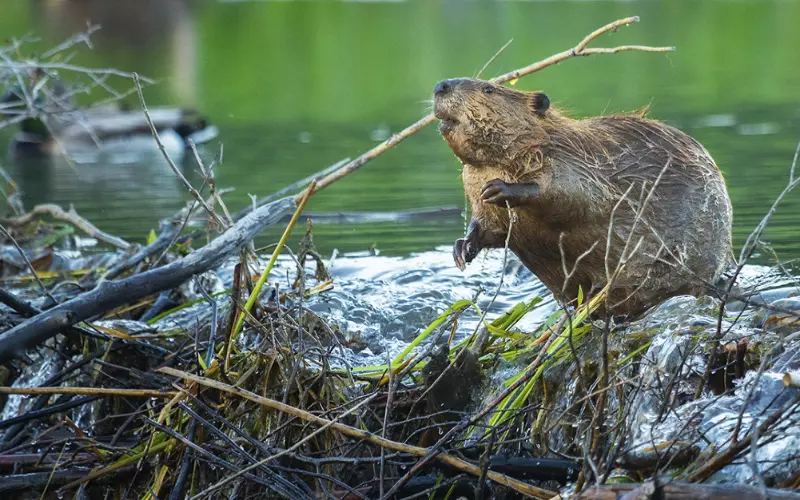
Beavers play a crucial role in ecosystems and significantly impact the environment. Here are some essential ways in which beavers contribute to the ecosystem:
- Wetland Creation: Beavers are nature’s engineers. They build dams using sticks, mud, and stones to block streams and create ponds. These ponds turn into wetlands, which are precious habitats. Wetlands provide homes for various plants and animals, including frogs, turtles, fish, and waterfowl.
- Water Filtration: Beaver ponds act as natural water filters. They trap sediments and pollutants, making the water cleaner. This benefits not only the aquatic life within the pond but also downstream ecosystems and even nearby communities that rely on clean water.
- Flood Control: Beaver dams can help regulate water flow and reduce the risk of flooding. By slowing down and storing water, they can prevent downstream areas from being overwhelmed during heavy rains.
- Habitat Enhancement: Beavers create a mosaic of habitats. Their activities promote the growth of aquatic plants and trees along the edges of their ponds, providing food and shelter for various species, including insects, birds, and mammals.
- Carbon Storage: Beaver ponds capture and store organic material in the sediments at the bottom. This helps sequester carbon, contributing to the fight against climate change.
- Biodiversity: Beavers’ work increases biodiversity by creating diverse aquatic and wetland ecosystems. The presence of these ecosystems supports a wide range of species, which, in turn, attracts predators and scavengers.
While beavers sometimes face challenges due to conflicts with human activities, understanding their role in ecosystems has led to efforts to protect and conserve these remarkable animals. Recognizing their importance helps us appreciate the intricate web of life that depends on healthy, functioning wetland ecosystems.
Natural Habitats of Beavers
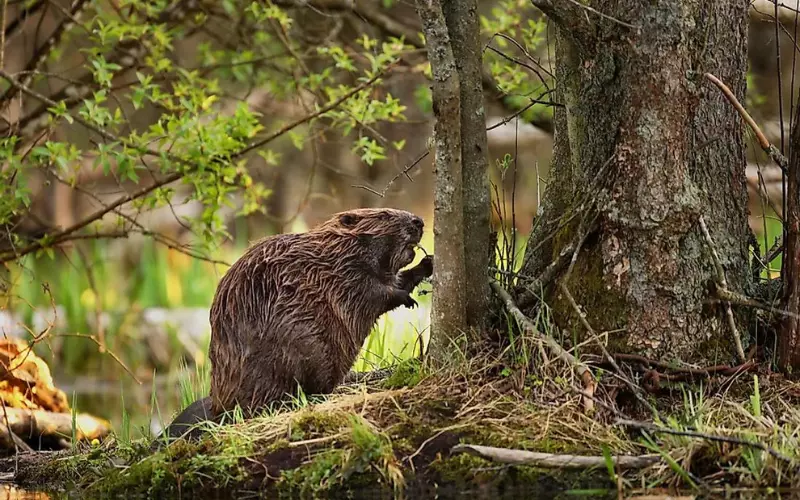
Beavers are primarily found in North America, Europe, and Asia. Their natural habitats include freshwater ecosystems such as rivers, streams, ponds, and lakes. They prefer areas with a combination of water and nearby woody vegetation, as they are semi-aquatic creatures. Beavers build lodges and dams using sticks, mud, and stones to create shelter and to regulate water levels.
Their lodges are constructed in the middle of ponds or along riverbanks, protecting them from predators and harsh weather. Beaver colonies, known as “colonies,” consist of family groups, including parents (adults), kits (young beavers), and yearlings.
Beavers are highly adaptable and have even been observed in urban areas, constructing lodges in city parks and suburban water bodies. Their impressive engineering skills and ability to modify their environments make them a keystone species in various ecosystems.
Challenges Faced by Beavers
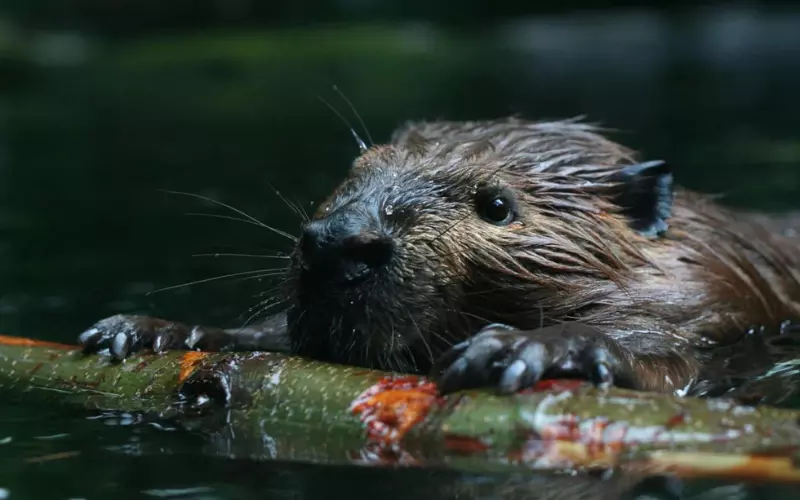
Beavers, despite their remarkable adaptations and abilities, face several challenges in their natural habitats:
- Habitat Loss: The conversion of natural habitats into urban areas and agriculture has led to the loss of suitable beaver habitats. This limits their access to appropriate food and building materials.
- Water Pollution: Water pollution from agriculture, industry, and urban runoff can contaminate the water sources where beavers live, affecting their health and the health of their ecosystems.
- Trapping and Hunting: Historically, beavers were hunted extensively for their fur, significantly declining their populations. Although regulated hunting is now in place in many areas, it remains a threat.
- Road Mortality: Beavers sometimes venture onto roads where vehicles can strike them. This is a common cause of mortality for beavers, especially in areas with high traffic.
Efforts are being made in many places to address these challenges through conservation programs, habitat restoration, and responsible management practices. Recognizing the vital role that beavers play in ecosystems and finding ways to coexist with them is crucial for their long-term survival.
Conclusion
Alright, little explorers, we’ve taken a fun journey to discover animals that look like beavers! Remember, while beavers are unique, there are other critters out there that might make you do a double-take.
We met the muskrat, which looks like a smaller cousin of the beaver, with a long tail and fur that helps it swim in the water. Then, we found the coypu, also known as the “river rat,” with big teeth and a bit of a beaver-ish look.
Nature creates different animals with similar features, and it’s super cool to learn about them. Each animal has its own story and role in the environment.
So, next time you’re near the water and spot a furry friend that looks like a beaver, you’ll know that it might not be a beaver after all! Keep exploring and learning about the amazing creatures sharing our planet. Who knows what other surprises nature has in store for us to discover?
FAQ’s
What animal looks like a beaver?
Animals like muskrats, coypus, and nutrias resemble beavers.
What is the big animal that looks like a beaver?
The capybara is a large animal that resembles a big beaver.
What animal looks like a beaver rat?
The muskrat is sometimes called a “beaver rat” because it resembles a beaver.
What animal looks like a beaver but has a rat tail?
The muskrat looks like a beaver but has a long, rat-like tail.
What animal looks like an otter?
Minks and otters can appear similar, especially in the water.
Is it a beaver or a muskrat?
Beavers and muskrats are different animals but share some similarities.
What does a muskrat look like?
Muskrats resemble small beavers with brown fur and a long, skinny tail.
What animal looks like a mink?
Martens and sables resemble minks.
What animal looks like a mongoose?
Weasels and stoats share some similarities with mongooses.
What is a mink look like?
Minks are sleek, dark-furred animals with long bodies and short legs.
What does a shrew look like?
Shrews are tiny creatures with pointy noses, small bodies, and dense fur.
Is the muskrat native to India?
Muskrats are not native to India; they are primarily found in North America.
Is it platypus or beaver?
Platypus and beaver are very different animals; platypus has a duck-like bill, while beavers are rodents.
Are giant beavers still alive?
No, giant beavers, also known as Castoroides, are extinct.

Hi there! I’m Morgan Gutierrez, and I love animals! I work as a Seasonal Animal Care Specialist at Brookfield Zoo and also teach people about animals, which is super fun. I studied at Valparaiso University in Lockport, Illinois, where I learned even more about these amazing creatures.
I’m not just about taking care of animals; I write articles about them, too! I explore and share many interesting animal stories, from cute kittens to giant elephants.
In the past, I’ve worked with veterinarians, helped with research, and even been an Animal Ambassador, bringing animals closer to people. Animals are my passion, and I enjoy helping others learn about them. So, if you ever want to know about animals, feel free to ask. I’ll explain it in a way that’s easy to understand, just like talking to a friend!

